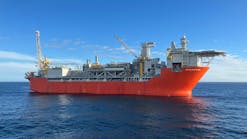Five pipeline companies have withdrawn from a $230 million joint project meant to deliver as much as 1.2 bcfd of gas from Mobile Bay to U.S. interstate markets.
ANR Pipeline Co., Florida Gas Transmission Co., Southern Natural Gas Co., Tennessee Gas Pipeline Co., and Texas Eastern Transmission Corp. said they withdrew because the Federal Energy Regulatory Commission rejected their request to remove at-risk conditions. Removal would have allowed construction to proceed.
Their Mobile Bay settlement emerged last fall as a plan to consolidate competing projects by the five pipelines and Transcontinental Gas Pipe Line Corp. (TGPL) to tap gas reserves in Mobile Bay off Alabama (OGJ, Oct. 8, 1990, p. 42).
Estimates of Mobile Bay reserves range as high as 25 tcf.
The five pipelines said FERC's rejection of their request to remove the at-risk conditions made the project economically infeasible.
"Mobile Bay will be only the first casualty of FERC's action," pipeline officials said.
"Its new pipeline construction policy in Order 555 effectively will limit construction of new, major projects-an outcome that runs contrary to Congress', the administration's, and even FERC's goal of increasing consumers' access to natural gas."
TGPL LINE
TGPL continues to operate an intrastate line that would have been the core of the Mobile Bay project. Built in 1987 at a cost of $90 million, TGPL's 123 mile, 30 in. pipeline is transporting 75 MMcfd of gas from Mobil Exploration & Producing U.S. inc.'s processing plant in Mobile County, Ala., to a connection with TGPL's main line near Butler, Ala.
TGPL expects to increase throughput to about 395 MMcfd later this year with about 160 MMcfd of added gas production each from Mobil and Shell Offshore Inc.'s Yellow Hammer processing plant.
"We also disagree with FERC's rule, but we already have our investment and risk defined since our pipeline is already built," TGPL said. "For the others coming in, it was a different situation."
Several of the pipelines that withdrew said they will begin seeking other alternatives to transport gas from prolific Mobile Bay.
The six pipelines last January asked FERC to approve an agreement to merge their proposed projects into a single, joint onshore and offshore pipeline system (O J, Feb. 4, p. 62).
FERC approved the settlement last June 4 but imposed certain at-risk conditions the pipelines considered unacceptable in view of the U.S. gas surplus and gas industry restructuring.
In its final order issued Oct. 15, FERC refused the pipelines' request to remove at-risk conditions. That killed the project.
ORDER 555
FERC issued Order 555 Sept. 20, giving sponsors of proposed pipelines a menu of construction and rate options.
The rule will become effective Nov. 19, but the Natural Gas Supply Association, Interstate Gas Association of America, and other groups last week asked FERC to reconsider.
Order 555 merges existing rules for optional pipeline certificates with Natural Gas Act Section 7(c) rules governing traditional proposals.
Under traditional pipeline certificates, FERC determines a project is economically sound, then allows construction and operating costs to be rolled into the pipeline's rate base, allocating those costs among customers for the gas.
Order 555 reduces the number of construction permits required, creates a rate-making procedure that allows pipelines and customers to negotiate rate terms, and sets procedures for meeting environmental requirements.
The order's most controversial provision creates a framework that requires sponsors to bear the risk of recovering construction costs if the project does not meet traditional criteria in the certification process.
Projects meeting a modified "Kansas standard," which requires them to show they have 10 year contracts for 1 00% of the daily capacity of proposed facilities, will be allowed to recover all construction costs.
But if a facility fails to meet the criteria, its initial rates will be based on minimum throughput conditions, allowing full cost recovery only if the facility operates at or near full capacity year round,
Ingaa Chairman Ronald Kuehn, chairman and CEO of Sonat Inc., said the order conflicts with FERC's pending pipeline service obligation rulemaking and should be deferred until after the latter is issued.
He said Order 555's new environmental requirements will increase, not reduce, the time required to plan and build projects, and the rate structure revisions are unrealistic.
"Today, the majority of natural gas commerce takes place on an extremely short term, spot market basis using interruptible services, and against this background a 10 year contract is truly rare."
NGSA agreed, telling FERC the rule provides no slack for normal pipeline shutdowns, supply interruptions, or the normal increase and decrease of production from a natural gas field over time.
It said the minimum throughput conditions give pipeline sponsors a strong incentive to underside their lines or abandon projects outright.
"Moreover, because the minimum throughput conditions will determine initial rates for a facility, they will discourage any facility that does not reach its maximum throughput until some time after construction."
NGSA also argued the rule should require new pipelines to allow interconnections paid for by third parties.
Copyright 1991 Oil & Gas Journal. All Rights Reserved.


